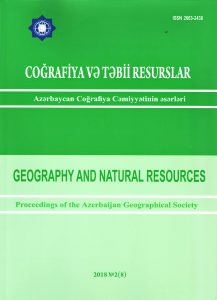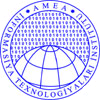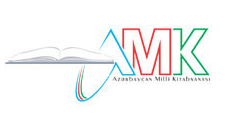ENIGMATIC DISCOVERY OF BRAZIL - I PARTAfter 9 days – on May 1 – Friday Cabral decided to put wooden cross with slogan and emblem of the king of Portugal on lands he had “discovered”. On the same day Cabral sent Gaspar de Lemos to Lisbon with his vessel in order to inform the king about lands he had “discovered”. He noted that, “discovered” territory would be called True Cross Island (Vera Cruz). According to historical sources, that news didn’t surprise Manuel I (1469-1521). After some time, the king changed name of that territory, called it “Santa Cruz” (Holy Cross) and informed other monarchs of Europe about this fact. 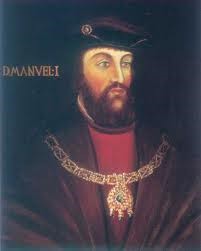 King of Portugal Manuel I (1469-1521) The North Passat blows from east to west, the equatorial current moves from west to east and the South Passat blows from east to west. The Passat blowing from east to west has also to be mentioned. But in spite of it, scientists use this factor – currents moving towards the west and declare that, Cabral lost his way in the ocean and reached other place. Was it possible to change the main way as B. Dias was there? Of course, it wasn’t possible! If such serious mistake was made with participation of Dias, who knew eastern coasts of the Atlantic Ocean very well, how he could reach the Cape of Good Hope located at 10 thousand km away from Lisbon? So questions appear in accordance with that enigmatic discovery. One of main questions: might Cabral make that mistake and change the course according to the secret task of the king of Portugal Manuel I? If we investigate everything in strict succession, we can see that, there are a lot of obscurities in the discovery of Pedro Cabral. It continued travel towards the west after passing the equator and approached Brazilian coasts at 170 south latitude on April 22. The expedition sailed directly towards the south after leaving San Nicolas Island – one of the central islands of the Green Cape Islands with 12 vessels on March 22. San Nicolas Island is situated at 240 west longitude, Corumba Cape of Brazil is situated at 390 west longitude. It means that, the squadron had moved away from its southern line for 150 towards the west. It is equal to 1600 km at the latitude of Corumba Cape. Pascual Mountain (536 m) discovered by Cabral is situated at 170 south latitude in the west of Corumba Cape and San Nicolas Island is situated at 160 37/ north latitude. I. P. Magidovich and V. I. Magidovich write that vessels had to sail 330 30/ towards the latitude of Pascual Mountain and it was equal to about 3700 km. According to information given by Pero Caminha, navigators had noted in their reports that they had overcome 4000 km. Then it isn’t convincing that, Cabral changed the course directly towards the west after sailing 170 west latitude towards south.1 So we may come to the following conclusion: the leader of the expedition wasn’t Cabral at the ocean passage, it was managed by the seaman, who knew that route very well. Otherwise, seamen might meet with difficulties. It is absurd to lose way when the compass is available. But it was possible from certain point of view at that time. It is possible to dodge from the fixed course when the weather is so foggy or windy, but this deviation may be 300-400 km or 500-700 km when storm is so heavy. According to diaries of the expedition, Portuguese didn’t meet any serious natural calamity before passing the equator. It means that, it was impossible to lose way as the weather was good. 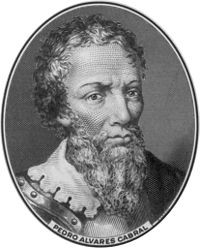 Pedro Alvaresh Cabral (1467-1520) So, we have to touch upon very important problem. But Portuguese changed the course towards the Cape of Good Hope located in the south of Africa after leaving “Vera-Crush” “discovered” on May 2. Though they sailed 7300 km, didn’t lose their way and reached the island soon. It means that, Portuguese navigators, who were very skilful in maneuvering in the open ocean, couldn’t reach Brazilian coasts by dodging from the main course when sailed from Green Cape Islands to the Cape of Good Hope. If it happened – if the expedition lost its way and reached Brazilian coasts, it would lose its way when sailed to the Cape of Good Hope as Portuguese sea travelers used that route for the first time. Besides it, Portuguese put big wooden cross on the coast instead of the stone emblem indicating that mentioned territory belonged to the Portugal Kingdom. What it was? It was next negligence or discovered lands weren’t so significant? If that discovery wasn’t important for Portuguese, why did Cabral send one of vessels, which had to sail to India to Lisbon in order to give information about the discovery? It means that, the discovery of Brazil had been planned beforehand and the world community had to be informed about it. As English seamen sailed in northern latitudes only, they couldn’t discover today’s Brazil. Besides it, they didn’t want to enter territories of Spaniards and Portuguese. According to historical sources, participant of Cabral’s expedition – Duarte Pereira had been in lands located on the other side of the Atlantic Ocean. It may be seen unconvincing. As Cabral had to register the “discovery of Brazil” when travelled to India, he needed a person knowing those coasts very well in order to prevent any unexpected events on their way. This person was Pereira. The date of that history is unknown. Well-known captain, explorer and cartographer Duarte Pacheco Pereira (1469-1533) had participated in expeditions in western coasts of Africa after II part of 80th years of XV century, met an accident near the Principle Island in 1488 and was rescued together with several seamen by the expedition of Bartolommeo Dias, who was returning from the Cape of Good Hope. He had participated in several secret expeditions, which’s route, geographical coordinates and coast lines were coded. 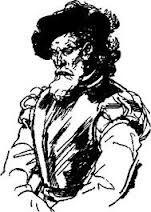 Duarte Pacheco Pereira (1469-1533) The author gave information about existence of lands located on the other side of the Atlantic Ocean in the mentioned book and noted that he had visited those lands six years before Cabral’s expedition.2 Some scientists wanted to use this fact and to show Pereira as the discoverer of South America in 1494. The discovery of South America by Pereira was described in the large article of I volume of Pereira da Silva’s work “The history of the Portuguese colonization of Brazil”. 3 Though original documents don’t exist, it is convincing that, Pereira had approached Brazilian coasts before Cabral. Concrete date is also mentioned as 1494. I also determined at the result of my investigations that, Pereira could reach Brazilian coasts first of all. (Continue of article: “Bulls of Popes or division of the world”) Best regards, the member of Azerbaijan Geographic Society, President grant holder on literature, laureate of the “Golden pen” award, writer/ investigator Ramiz Daniz 2 И. П. Магидович, В. И. Магидович. Очерки по истории географических открытий, II том. Москва, “Просвещение”. 1982. стр. 55
3 Portu, 1923 il, portuqal dilində.
1 И. П. Магидович, В. И. Магидович. Очерки по истории географических открытий, II том. Москва, “Просвещение”. 1982. стр.54.
 28889 28889 |
|








 AZ
AZ EN
EN RU
RU


